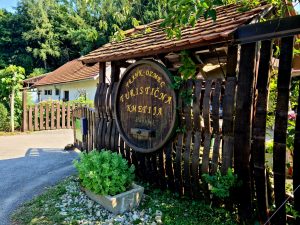No. I couldn’t have heard him correctly. A history spanning 7000 years? Malta? It seems like just a couple of years ago that I first heard of the place. Could it be that old? So I checked. And the guide was right. Malta was first settled in 5200 BC. So then I checked Ireland. It was first settled in 8000 BC. Conclusion: I have no clue about history and even less about geography. How sad is that?

Some trivia for you: Malta is a group of seven islands in the Mediterranean Sea. Only the three largest are inhabited: Malta, Gozo, and Comino. They stand on an underwater ridge that extends from North Africa to Sicily (which is about 100 km north – you can get there by hovercraft and it’s high on my list of things to do). The islands were once submerged and the bones of elephants and hippopotami have been found in caverns along the coast. Phoenicians, Carthaginians, Romans, Arabs, and Normans all came and stayed awhile before the King of Spain gave it to the Knights Hospitaller of St John in 1530. Verdi’s opera Sicilian Vespers immortalised the 1283 naval battle of the same name, a battle that ended French/Norman control of Sicily and the Maltese Islands. The Turks made a bid for the islands in 1565 but the Knights saw them off. In 1607, a young painter by the name of Michaelangelo Merisi was vested as official painter of the Knights of St John – you might know him as Caravaggio. Two of his greatest works – St Jerome writing and The beheading of John the Baptist still hang in the Co-Cathedral of St John in Valetta. There’s another new one for me: co-cathedral. The Bishop of Malta had his cathedral in Mdina; the Knights had theirs in Valetta. In 1820, the Knights allowed the Bishop (was chess invented in Malta???) to use their cathedral as an alternative see – hence the ‘co’ in co-cathedral.
Napoleon stopped by in 1798 on his way to Egypt but didn’t get a great reception. When he was refused water, he sent in the troops and the Grand Master capitulated. He stayed only a few days but spent his time pilfering anything worth taking. Before he left, he established an administration to run the place in his absence. During his tenure, he freed 2000 Muslim slaves and established a liberal lay system to replace the existing feudal one. The locals welcomed the French… for a while… but when they started closing convents and seizing church treasures, a line was drawn. They asked the British for help and Nelson arrived, blockaded the place, and in 1800 the French surrendered.
Malta then voluntarily became part of the British Empire. Under the terms of the 1802 Treaty of Amiens, Britain was supposed to evacuate the island, but sort of forgot to leave. Although small in size and not initially given much importance, Malta’s harbours soon became a jewel in the Empire’s crown, headquarters to the British Mediterranean fleet. 
While Home Rule effectively started in Ireland in 1870 (but it was a long and arduous process), the Maltese had to wait until 1921 (interestingly, the same year as Northern Ireland). Malta got its independence in 1964 and joined the EU in 2004.
Before the British arrived, the Maltese spoke Italian and had done so since 1530. In 1934, English and Maltese were declared the official languages. On 21st September 1964 Maltese officially became the national language of Malta, although English and Italian are also spoken. Their accent is unique and a joy to listen to. Now that I have my head around the 7000 years, and have overcome my shame at being so ignorant, I’m looking forward to seeing a little more of these seven islands in the Med with Air Malta.
Share this:
- Click to share on X (Opens in new window) X
- Click to share on Facebook (Opens in new window) Facebook
- Click to share on Pinterest (Opens in new window) Pinterest
- Click to share on LinkedIn (Opens in new window) LinkedIn
- Click to share on Reddit (Opens in new window) Reddit
- Click to share on WhatsApp (Opens in new window) WhatsApp
- Click to share on Pocket (Opens in new window) Pocket
- Click to share on Telegram (Opens in new window) Telegram
- Click to email a link to a friend (Opens in new window) Email







